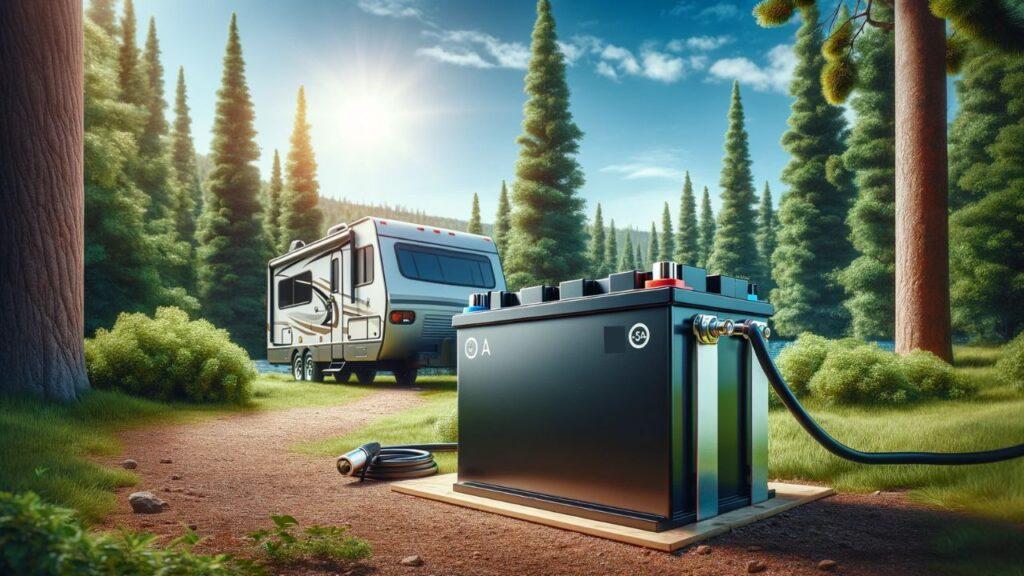
Cassette toilet vs composting toilet—which is better for van life? Cassette toilets are compact and easy to empty, while composting toilets are eco-friendly and great off-grid. Van life has skyrocketed in popularity, with the number of van dwellers in the United States jumping 63% in just two years—from 1.9 million in 2020 to 3.1 million in 2022.
With this lifestyle shift comes a big question: where do you “go” when you’re on the road? If you’re building or upgrading your van, choosing the right toilet is a big deal.
Let’s dive into two popular options—cassette toilets and composting toilets—and see which one fits your van life needs.
What Are Cassette Toilets?
A cassette toilet is a portable or semi-permanent toilet designed for RVs and vans. It has a small holding tank (usually around 5 gallons) that collects waste and can be removed for emptying.
Cassette toilets mimic the convenience of a household toilet but with some key differences tailored to life on the move.
The waste tank is detachable and often comes with wheels and a handle, making it easy to transport to a dump station. This makes them a popular choice for van lifers who want a straightforward and familiar toilet setup.
These toilets typically require chemical treatments in the holding tank to control odor and break down waste. While they feel more like a traditional toilet, they need regular emptying, especially for full-time van dwellers.
How Do Cassette Toilets Work?
Cassette toilets work by collecting waste in a portable holding tank beneath the toilet seat. Before use, a small amount of water and a chemical additive are placed in the tank to minimize odors and help with waste decomposition.
To use the toilet, you open a trap door that connects the toilet bowl to the tank. After flushing, the waste drops into the tank, where it mixes with the chemicals.
Most models include a manual or electric flush mechanism, which uses water from the van’s plumbing system or a separate reservoir.
When the tank is full, you remove it via an exterior access door or directly from the toilet. The tank can then be emptied at a dump station, rinsed out, and prepared for reuse.
Pros and Cons of Cassette Toilets
Cassette toilets are convenient and portable, but they do come with a mix of advantages and drawbacks.
Pros:
- Affordable Upfront Cost: Cassette toilets are much cheaper than composting options, with prices ranging from $70 to $300.
- Familiar Design: They feel similar to a traditional toilet, which makes them easy to use for most people.
- Compact and Space-Saving: These toilets are designed to fit in tight spaces, making them ideal for smaller vans.
- Portable Waste Tank: The removable tank with wheels makes it simple to transport for emptying.
- Widely Available: Replacement parts, chemicals, and support for cassette toilets are easy to find.
Cons:
- Frequent Emptying: The 5-gallon holding tank fills up quickly, especially for two or more people.
- Odor Issues: Even with chemicals, odors can persist if the tank isn’t emptied regularly.
- Reliance on Chemicals: Managing odors and waste requires ongoing chemical treatments, which add to running costs.
- Dump Station Dependency: Waste must be disposed of at designated dump stations, which can be inconvenient.
- Weak Flush Mechanism: The flush often lacks power, which may leave residue in the bowl and require extra cleaning.
What Are Composting Toilets?
A composting toilet is a waterless, eco-friendly toilet that separates liquids from solids and uses natural materials like coconut coir to aid in waste decomposition.
Composting toilets don’t rely on chemicals or water, making them a greener alternative. They’re especially popular with van lifers who want to minimize their environmental impact. By separating liquids and solids, they prevent odors and make disposal easier.
The solids container typically uses a fan to draw out moisture and aid in drying the waste, while the liquids container can be emptied separately. These features make composting toilets an excellent choice for those prioritizing long-term sustainability.
How Do Composting Toilets Work?
Composting toilets work by separating liquid and solid waste into two different compartments. When you use the toilet, liquid waste is funneled into a sealed container, while solid waste drops into a larger bin pre-loaded with coconut coir, peat moss, or a similar material.
The solids bin uses a small vent fan to remove odors and speed up drying. After each use, you turn a crank or agitator to mix the waste with the composting material.
This process reduces odor and allows the waste to begin breaking down.
Once the urine container is full, it can be emptied into a public toilet, sewage system, or dispersed responsibly in nature. The solids bin needs to be emptied every 2-3 weeks, depending on usage, and the contents can be bagged and disposed of in a dumpster.
Pros and Cons of Composting Toilets
Composting toilets are eco-friendly and odor-free but require more maintenance and a higher upfront cost.
Pros:
- Eco-Friendly: Uses no water or chemicals, reducing environmental impact.
- Odor-Free: The vent fan and separation system eliminate most smells.
- Infrequent Emptying: Solids only need to be emptied every 2-3 weeks for two people.
- Sustainable Waste Disposal: Solids can be composted (if allowed) and liquids disposed of easily.
- Great for Off-Grid Living: No need for water hookups or dump stations.
Cons:
- High Initial Cost: Prices start around $400-$600, which is a significant investment.
- Bulky Design: Composting toilets require more space than cassette models.
- Requires Electricity: The fan needs a 12V power supply, which may not suit every setup.
- Learning Curve: Users must adapt to separating waste and using composting materials.
- Emptying Urine: The urine container fills up quickly and emits a strong ammonia smell when dumped.
What Are the Key Differences Between Cassette Toilet and Composting Toilet?
Here are the key differences between a cassette toilet and a composting toilet:
- Cost: Cassette toilets are cheaper upfront, while composting toilets save on long-term costs.
- Smell: Composting toilets are nearly odor-free, while cassette toilets can have chemical or sewage odors.
- Emptying: Cassette toilets require frequent trips to dump stations, while composting toilets need less frequent emptying.
- Eco-Friendliness: Composting toilets are chemical-free and waterless, making them better for the environment.
- Ease of Use: Cassette toilets are simpler to use but require handling chemicals. Composting toilets have a learning curve but are low-maintenance.
Let’s break these down further.
Cost
Cassette toilets are the budget-friendly choice upfront, costing between $70 and $200. Composting toilets, on the other hand, range from $400 to $1,000.
While cassette toilets are cheaper initially, the running costs add up over time. Chemicals for the waste tank, which cost $10 to $20 per bottle, are required frequently.
For composting toilets, the ongoing costs are minimal, with materials like wood shavings and vinegar available at low prices or even for free.
Smell
Composting toilets win the smell category hands down. The venting system and separation of liquids and solids minimize odors inside the van. Outside, composting toilets are virtually odorless, especially if coconut coir is used.
Cassette toilets, however, can smell like chemicals or sewage, especially as the tank fills up. While chemical additives help, they don’t always eliminate the odor entirely.
Emptying
Cassette toilets require emptying every 2–3 days for two people, and the process can be unpleasant. The tank must be taken to a designated dump station, where you’ll deal with raw sewage and strong smells.
Composting toilets, in contrast, only need the urine container emptied every 2 days and the solids bin every 2–3 weeks. The solids are dry and easier to handle, making this process less messy overall.
Eco-Friendliness
Composting toilets are waterless and chemical-free, making them the eco-friendlier option. Their waste can be safely composted under proper conditions.
Cassette toilets rely on water and chemicals, which increase their environmental footprint. Disposing of chemically treated waste at dump stations also contributes to wastewater pollution.
Ease of Use
Cassette toilets feel more like traditional toilets, making them easy to use. However, managing chemicals and dealing with frequent emptying can be a hassle.
Composting toilets require some adjustment, such as separating waste and turning a crank for the composting process. Once you get the hang of it, they’re low-maintenance and straightforward.
Cassette Toilet vs Composting Toilet: Long-Term Costs
Cassette toilets are cheaper upfront, costing $70–$200, but their ongoing expenses for chemicals can add up over time. Composting toilets, priced at $400–$1,000, have minimal long-term costs, making them more economical in the long run.
Cassette Toilet Costs
The main recurring expense for a cassette toilet is the chemical treatments needed to manage odors and break down waste.
A 32-ounce bottle costs around $10–$20 and lasts about eight cleaning cycles. With frequent emptying, these costs can quickly add up, making cassette toilets more expensive over time.
Composting Toilet Costs
Composting toilets require materials like wood shavings or coconut coir, which are either free or very cheap. Vinegar for cleaning is another small expense, costing around $20 for a gallon that can last over a year.
Composting bags, used for disposing of solids, cost about $5 for a pack of 25. Together, these minimal expenses make composting toilets a cost-effective choice.
Key Comparison:
- Cassette Toilet: Ongoing cost ~ $0.50/day for chemicals.
- Composting Toilet: Ongoing cost ~ $0.09/day for materials.
While the upfront cost of a composting toilet is higher, the lower daily expenses make it the better investment for long-term van life.
Cassette Toilet vs Composting Toilet: Which Toilet Is Right for You?
The right toilet for you depends on your budget, lifestyle, and priorities. Choose a cassette toilet for affordability and simplicity or a composting toilet for eco-friendliness and less frequent emptying.
If you’re on a tight budget or only travel occasionally, a cassette toilet might be the best fit. They’re affordable, easy to install, and familiar to use. However, frequent emptying and chemical usage can become a hassle for full-time travelers.
On the other hand, composting toilets are perfect for eco-conscious van lifers who want a low-maintenance, odor-free solution. They’re more expensive upfront but pay off in long-term savings and convenience, especially for off-grid living.
How to Choose the Right Toilet for Your Van Layout
When deciding on a toilet, consider your van’s layout, space, and power availability. Ask yourself these questions:
- How much space can I dedicate to a toilet?
- Do I have access to 12V power for a vent fan?
- Will I mostly camp off-grid or near dump stations?
- Am I comfortable handling chemicals or composting waste?
- What is my budget for upfront costs and long-term expenses?
Your answers will help guide your choice between a compact, chemical-based cassette toilet and a larger, eco-friendly composting option.
Conclusion
Choosing between a cassette toilet and a composting toilet comes down to your priorities and lifestyle. Cassette toilets are affordable and straightforward, but they require frequent emptying and ongoing chemical costs. Composting toilets, while pricier upfront, are eco-friendly, low-maintenance, and ideal for off-grid living.
For occasional travelers, a cassette toilet may suffice. For full-time van lifers or those looking for a greener option, a composting toilet is worth the investment. Evaluate your van’s layout, budget, and usage needs to make the right decision for your adventures.
FAQs
Can I use a composting toilet and a cassette toilet together in the same van?
Yes, some van lifers choose to use both. A cassette toilet can serve as a backup for guests or emergencies, while the composting toilet is used for daily needs. Just ensure you have enough space to accommodate both.
What happens if I overflow the waste tank or urine container?
For cassette toilets, overflowing can lead to leaks and unpleasant messes. Always monitor the tank’s capacity using the level gauge. Composting toilets may spill urine if the container isn’t emptied in time, but placing a small catch pan can help avoid messes.
Do I need to winterize my toilet in cold climates?
Yes. For cassette toilets, add antifreeze (RV-safe) to the water tank to prevent freezing. Composting toilets are less affected by freezing temperatures but may need additional insulation for the vent pipe to function effectively.
Can I use regular toilet paper in both types of toilets?
Yes, but thinner, biodegradable toilet paper is recommended for cassette toilets to avoid clogs. For composting toilets, you can use regular toilet paper, but it slows decomposition, so many users prefer to dispose of it separately.
How often do I need to replace parts for these toilets?
Cassette toilets may need seal replacements or chemical treatments over time, usually every 1–2 years. Composting toilets typically require minimal maintenance, with vent fans or agitator handles lasting several years before needing replacement.
As outdoor enthusiasts ourselves, we understand the significance of reliable gear that can withstand the elements and support you throughout your journey. We try to provide as much real life information with our guides and how tos to the readers as possible. Our honest and transparent reviews of essential outdoor gadgets and products are rooted in testing and experience. We take great satisfaction in offering unbiased evaluations, ensuring that you can make informed decisions when investing in outdoor gear. As an affiliate website, we may earn a small commission from some of the products we feature. However, rest assured that our opinions are not influenced by this, and your trust is always our top priority.



